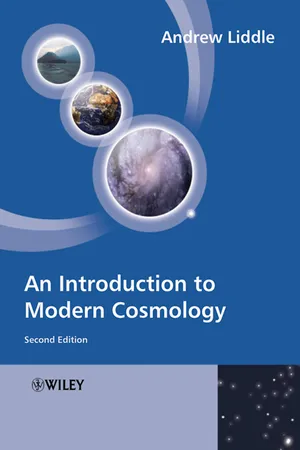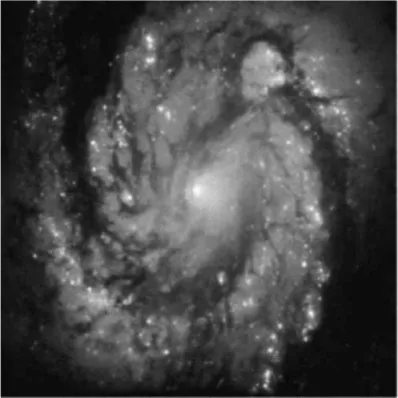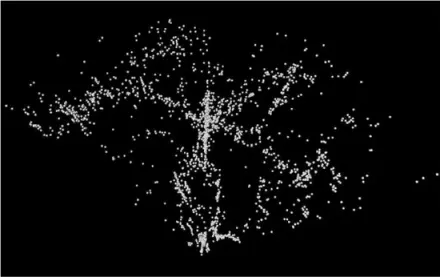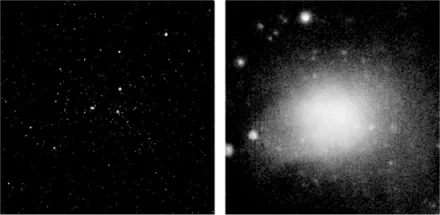![]()
Chapter 1
A Brief History of Cosmological Ideas
The cornerstone of modern cosmology is the belief that the place which we occupy in the Universe is in no way special. This is known as the cosmological principle, and it is an idea which is both powerful and simple. It is intriguing, then, that for the bulk of the history of civilization it was believed that we occupy a very special location, usually the centre, in the scheme of things.
The ancient Greeks, in a model further developed by the Alexandrian Ptolemy, believed that the Earth must lie at the centre of the cosmos. It would be circled by the Moon, the Sun and the planets, and then the ‘fixed’ stars would be yet further away. A complex combination of circular motions, Ptolemy’s Epicycles, was devised in order to explain the motions of the planets, especially the phenomenon of retrograde motion where planets appear to temporarily reverse their direction of motion. It was not until the early 1500s that Copernicus stated forcefully the view, initiated nearly two thousand years before by Aristarchus, that one should regard the Earth, and the other planets, as going around the Sun. By ensuring that the planets moved at different speeds, retrograde motion could easily be explained by this theory. However, although Copernicus is credited with removing the anthropocentric view of the Universe, which placed the Earth at its centre, he in fact believed that the Sun was at the centre.
Newton’s theory of gravity put what had been an empirical science (Kepler’s discovery that the planets moved on elliptical orbits) on a solid footing, and it appears that Newton believed that the stars were also suns pretty much like our own, distributed evenly throughout infinite space, in a static configuration. However it seems that Newton was aware that such a static configuration is unstable.
Over the next two hundred years, it became increasingly understood that the nearby stars are not evenly distributed, but rather are located in a disk-shaped assembly which we now know as the Milky Way galaxy. The Herschels were able to identify the disk structure in the late 1700s, but their observations were not perfect and they wrongly concluded that the solar system lay at its centre. Only in the early 1900s was this convincingly overturned, by Shapley, who realized that we are some two-thirds of the radius away from the centre of the galaxy. Even then, he apparently still believed our galaxy to be at the centre of the Universe. Only in 1952 was it finally demonstrated, by Baade, that the Milky Way is a fairly typical galaxy, leading to the modern view, known as the cosmological principle (or sometimes the Copernican principle) that the Universe looks the same whoever and wherever you are.
It is important to stress that the cosmological principle isn’t exact. For example, no one thinks that sitting in a lecture theatre is exactly the same as sitting in a bar, and the interior of the Sun is a very different environment from the interstellar regions. Rather, it is an approximation which we believe holds better and better the larger the length scales we consider. Even on the scale of individual galaxies it is not very good, but once we take very large regions (though still much smaller than the Universe itself), containing say a million galaxies, we expect every such region to look more or less like every other one. The cosmological principle is therefore a property of the global Universe, breaking down if one looks at local phenomena.
The cosmological principle is the basis of the Big Bang Cosmology. The Big Bang is the best description we have of our Universe, and the aim of this book is to explain why. The Big Bang is a picture of our Universe as an evolving entity, which was very different in the past as compared to the present. Originally, it was forced to compete with a rival idea, the Steady State Universe, which holds that the Universe does not evolve but rather has looked the same forever, with new material being created to fill the gaps as the Universe expands. However, the observations I will describe now support the Big Bang so strongly that the Steady State theory is almost never considered.
![]()
Chapter 2
Observational Overview
For most of history, astronomers have had to rely on light in the visible part of the spectrum in order to study the Universe. One of the great astronomical achievements of the 20th century was the exploitation of the full electromagnetic spectrum for astronomical measurements. We now have instruments capable of making observations of radio waves, microwaves, infrared light, visible light, ultraviolet light, X-rays and gamma rays, which all correspond to light waves of different (in this case increasing) frequency. We are even entering an epoch where we can go beyond the electromagnetic spectrum and receive information of other types. A remarkable feature of observations of a nearby supernova in 1987 was that it was also seen through detection of neutrinos, an extraordinarily weakly interacting type of particle normally associated with radioactive decay. Very high energy cosmic rays, consisting of highly-relativistic elementary particles, are now routinely detected, though as yet there is no clear understanding of their astronomical origin. And as I write, experiments are starting up with the aim of detecting gravitational waves, ripples in space-time itself, and ultimately of using them to observe astronomical events such as colliding stars.
The advent of large ground-based and satellite-based telescopes operating in all parts of the electromagnetic spectrum has revolutionized our picture of the Universe. While there are probably gaps in our knowledge, some of which may be important for all we know, we do seem to have a consistent picture, based on the cosmological principle, of how material is distributed in the Universe. My discussion here is brief; for a much more detailed discussion of the observed Universe, see Rowan-Robinson’s book ‘Cosmology’ (full reference in the Bibliography). A set of images, including full-colour versions of the figures in this chapter, can be found via the book’s Home Page as given in the Preface.
2.1 In visible light
Historically, our picture of the Universe was built up through ever more careful observations using visible light.
Stars: The main source of visible light in the Universe is nuclear fusion within stars. The Sun is a fairly typical star, with a mass of about 2 × 10
30 kilograms. This is known as a solar mass, indicated
, and is a convenient unit for measuring masses. The nearest stars to us are a few light years away, a light year being the distance (about 10
16 metres) that light can travel in a year. For historical reasons, an alternative unit, known as the parsec and denoted ‘pc’,
1 is more commonly used in cosmology. A parsec equals 3.261 light years. In cosmology, one seldom considers individual stars, instead preferring to adopt as the smallest considered unit the conglomerations of stars known as …
Figure 2.1 If viewed from above the disk, our own Milky Way galaxy would probably resemble the M100 galaxy, imaged here by the Hubble Space telescope. [Figure courtesy NASA]
Galaxies: Our solar system lies some way off-centre in a giant disk structure known as the Milky Way galaxy. It contains a staggering hundred thousand million (1011) or so stars, with masses ranging from about a tenth that of our Sun to tens of times larger. It consists of a central bulge, plus a disk of radius 12.5 kiloparsecs (kpc, equal to 103 pc) and a thickness of only about 0.3 kpc. We are located in the disk about 8 kpc from the centre. The disk rotates slowly (and also differentially, with the outer edges moving more slowly, just as more distant planets in the solar system orbit more slowly). At our radius, the galaxy rotates with a period of 200 million years. Because we are within it, we can’t get an image of our own galaxy, but it probably looks not unlike the M100 galaxy shown in Figure 2.1.
Our galaxy is surrounded by smaller collections of stars, known as globular clusters. These are distributed more or less symmetrically about the bulge, at distances of 5–30 kpc. Typically they contain a million stars, and are thought to be remnants of the formation of the galaxy. As we shall discuss later, it is believed that the entire disk and globular cluster system may be embedded in a larger spherical structure known as the galactic halo.
Figure 2.2 A map of galaxy positions in a narrow slice of the Universe, as identified by the CfA (Center for Astrophysics) redshift survey. Our galaxy is located at the apex, and the radius is around 200 Mpc. The galaxy positions were obtained by measurement of the shift of spectral lines, as described in section 2.4. While more modern and extensive galaxy redshift surveys exist, this survey still gives one of the best impressions of structure in the Universe. [Figure courtesy Lars Christensen]
Galaxies are the most visually striking and beautiful astronomical objects in the Universe, exhibiting a wide range of properties. However, in cosmology the detailed structure of a galaxy is usually irrelevant, and galaxies are normally thought of as point-like objects emitting light, often broken into sub-classes according to colours, luminosities and morphologies.
The local group: Our galaxy resides within a small concentrated group of galaxies known as the local group. The nearest galaxy is a small irregular galaxy known as the Large Magellanic Cloud (LMC), which is 50 kpc away from the Sun. The nearest galaxy of similar size to our own is the Andromeda Galaxy, at a distance of 770 kpc. The Milky Way is one of the largest galaxies in the local group. A typical galaxy group occupies a volume of a few cubic megaparsecs. The megaparsec, denoted Mpc and equal to a million parsecs, is the cosmologist’s favourite unit for measuring distances, because it is roughly the separation between neighbouring galaxies. It equals 3.086 × 1022 metres.
Clusters of galaxies, superclusters and voids: Surveying larger regions of the Universe, say on a scale of 100 Mpc, one sees a variety of large-scale structures, as shown in Figure 2.2. This figure is not a photograph, but rather a carefully constructed map of the nearby region of our Universe, on a scale of about 1:1027! In some places galaxies are clearly grouped into clusters of galaxies; a famous example is the Coma cluster of galaxies. It is about 100 Mpc away from our own galaxy, and appears in Figure 2.2 as the dense region in the centre of the map. The left panel of Figure 2.3 shows an optical telescope image of Coma; although the image resembles a star field, each point is a distinct galaxy. Coma contains perhaps 10 000 galaxies, mostly too faint to show in this image, orbitting in their common gravitational field. However, most galaxies, sometimes called field galaxies, are not part of a cluster. Galaxy clusters are the largest gravitationally-collapsed objects in the Universe, and they themselves are grouped into superclusters, perhaps joined by filaments and walls of galaxies. In between this ‘foamlike’ structure lie large voids, some as large as 50 Mpc across. Structures in the Universe will be further described in Advanced Topic 5.
Figure 2.3 Images of the Coma cluster of galaxies in visible light (left) and in X-rays (right), on the same scale. Colour versions can be found on the book’s WWW site. [Figures courtesy of the Digitized Sky Survey, ROSAT and SkyView ]
Large-scale smoothness: Only once we get to even larger scales, hundreds of megaparsecs or more, does the Universe begin to appear smooth. Recent extremely large galaxy surveys, the 2dF galaxy redshift survey and the Sloan Digital Sky Survey, have surveyed volumes around one hundred times the size of the CfA survey, each containing hundreds of thousands of galaxies. Such surveys do not find any huge structures on scales greater than those seen in the CfA survey; the galaxy superclusters and voids just discussed are likely to be the biggest structures in the present Universe.
The belief that the Universe does indeed become smooth on the largest scales, the cosmological principle, is the underpinning of modern cosmology. It is interesting that while the smoothness of the matter distribution on large scales has been a key assumption of cosmology for decades now, it is only fairly rece...




